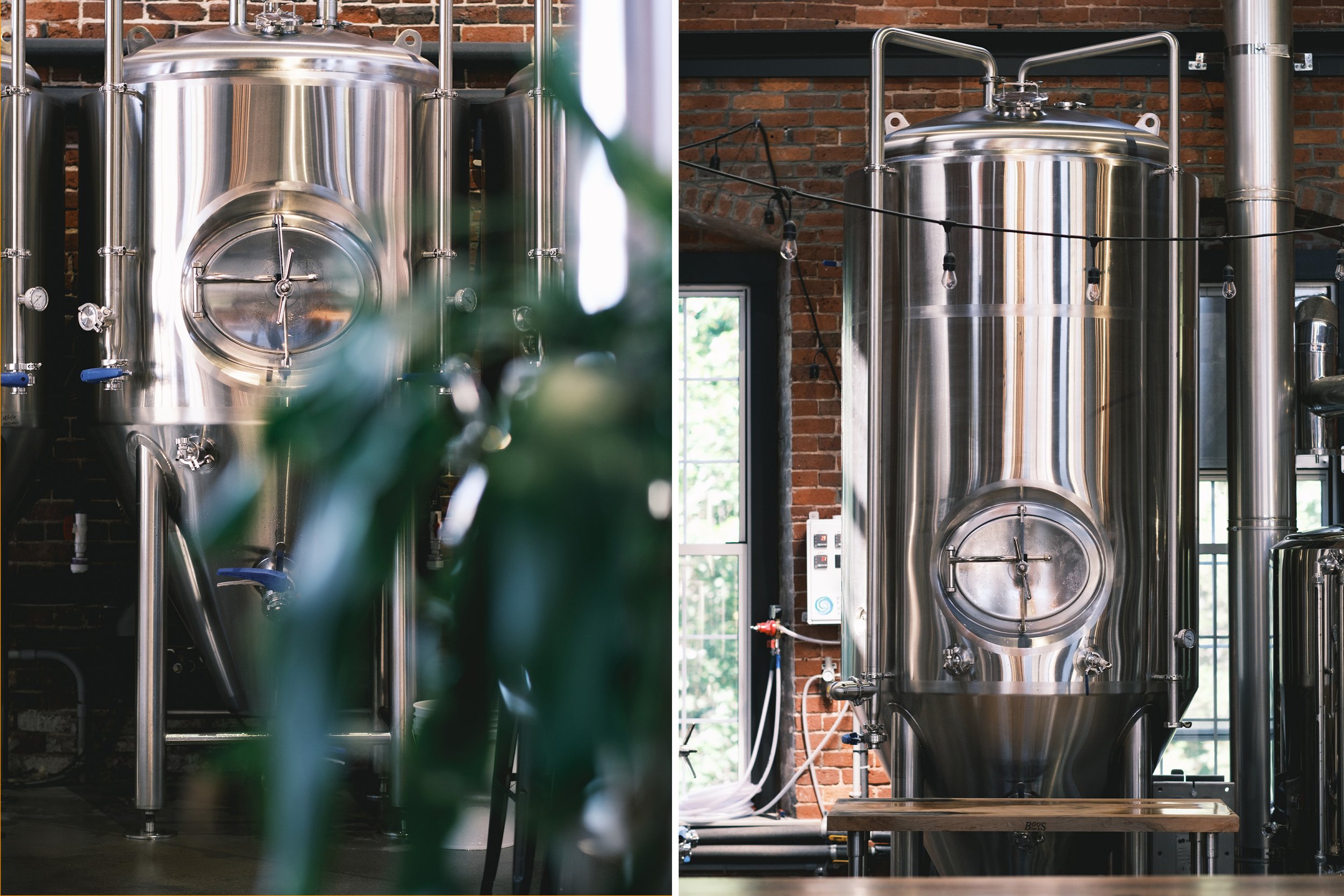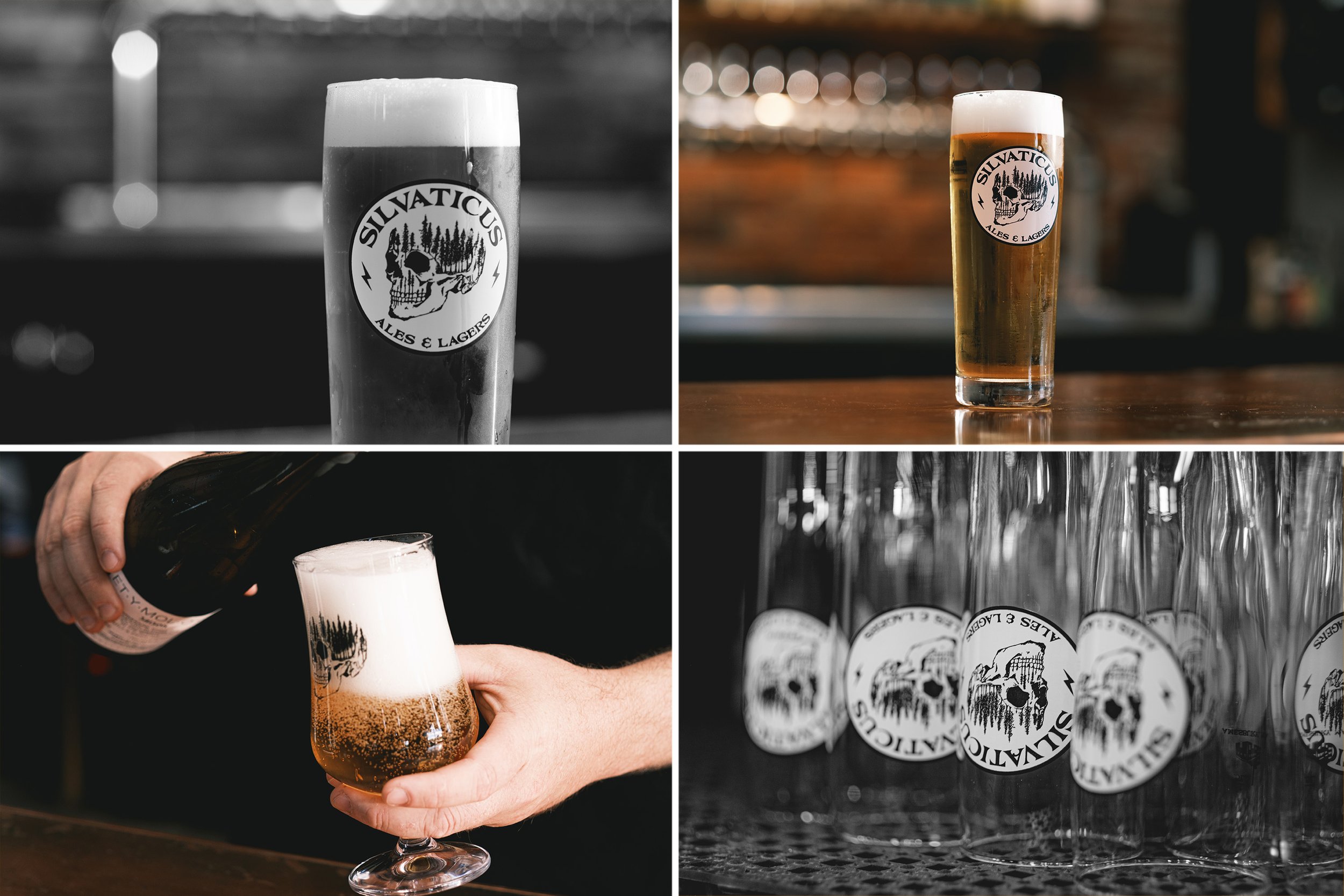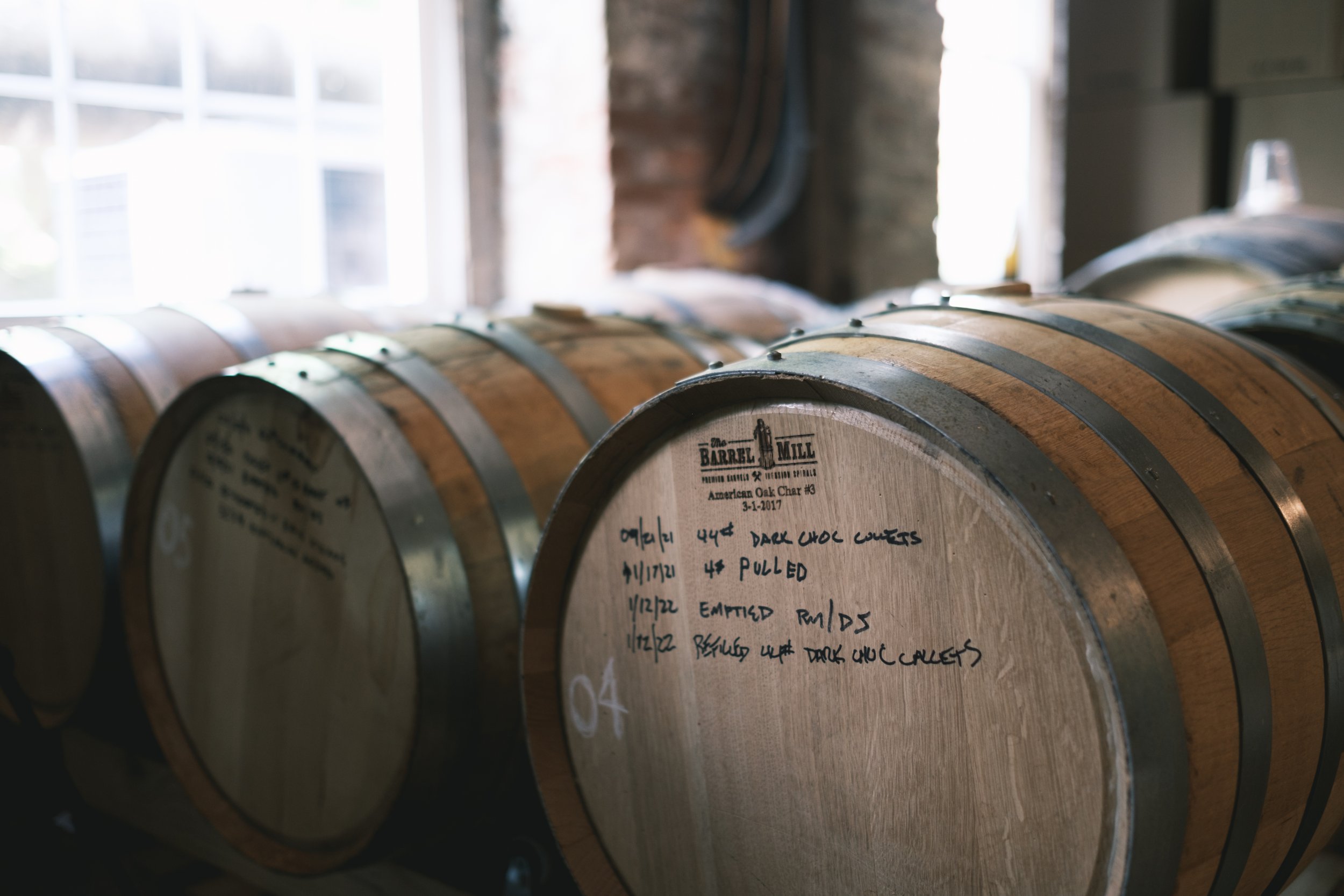Details matter. The way the westward-facing walls in a home allow the perfect amount of sunlight in. The angle of the grain on a red cedar bar. The placement of a frame. All rely on specificity and intent. Many details go unnoticed, but that’s part of the intention. We shouldn’t notice them right away. They shouldn’t be overt. After all, they’re details, not features.
Walking into Brewery Silvaticus in Amesbury, Massachusetts, there’s a sleek simplicity at first glance. It’s the small, 7-barrel system outlined against the red bricks of an old mill building; it’s a curved, hand-crafted bar flanked by wooden picnic tables; it’s a menu featuring mostly low-ABV Lagers and Belgian Ales. Jazz plays on a rainy Thursday morning as a batch of Bombshell, a Hefeweizen, gets its turn in the kettle.
“We knew from when we first stepped into [the building] that we didn’t have to do a lot,” says Jay Bullen, co-owner and director of brewhouse operations, while sipping on a still-unfinished test batch of a raspberry Lager. “I could keep it a little more utilitarian and do some accents, you know, simple little things. It just, it didn’t need much. I think that’s kind of like my approach to everything.”
Bullen, who co-owns the brewery with his wife, Michelle Riaz, owes some of this approach to his background in woodworking. The trade—honed in his father’s home improvement business in Staten Island and then in a cabinet shop in Northern California—taught him many lessons, but most of all the idea of intentional simplicity. Less is more.
“Intentionally simple is a great way to put it,” he says. “I don’t want to have to overthink it too much. That’s not to say that we don’t put great thought and detail into crafting a recipe. We’re always trying to try new things and different ingredients, but for the most part, we keep it pretty simple.”
What has resulted is one of those rare breweries that is both well-regarded by industry peers and beer consumers but also lacking in any distribution footprint or message-board hype. The journey to the small brick building on the Powwow River, though, didn’t begin so simply.
Bullen and Riaz are both from New York: Bullen from Staten Island, Riaz from Brooklyn. The pair began dating in 2004, their first date held at a Staten Island beer bar. A little into their courtship, Riaz was offered a job in Palo Alto, California. She, in turn, made Bullen an offer.
“I think I’m going to do it if you want to come with me,” she told him. “I thought, ‘Why not California?’” Bullen recalls. “There’s not really much going on [in Staten Island]. So she sold all her stuff, packed up the rest of it, and we moved out to California.”
Riaz launched into her career in retail management, but that left Bullen needing a job. Down the road from their place in Mountain View was a brewery called Tied House, which was a typical “five-color-flight-of-beers” brewpub of the early 2000s. “You know, your Blonde, your Wheat Ale, your Red Ale, your Amber, your Stout,” says Bullen, who worked there in a front-of-house and waitstaff capacity.
“Growing up in New York City, you’re always told New York City is the greatest place in the world and that’s where everybody wants to be. But there’s so many amazing places out in the world.”
Importantly, because the couple shared a car, Tied House was within walking distance of their home. In addition to Tied House, Bullen also worked at a cabinet shop called Knotty Hole Woodworks, which catered to high-end clients like Google, Yahoo, Hall of Fame football player Jerry Rice, and actress Michelle Pfeiffer.
“My time in the cabinet shop was great, because it taught me to be efficient,” says Bullen. “It taught me to have an eye for quality, for detail [...] I think that’s one of the things that kind of carries over from woodworking to brewing.”
Bullen and Riaz had another eureka moment in the Golden State: a newly discovered love of exploration. “We loved it out there,” says Riaz. “We took road trips. It was the first time we ever went camping.”
“We would go camping once a month,” Bullen remembers. “We hit up all the National Parks. We drove all over the place up and down the coast. We saw Death Valley, Sequoia, Yosemite and up through Redwood. It was really, really eye-opening for Michelle and I, as far as seeing what the world was. Growing up in New York City, you’re always told New York City is the greatest place in the world and that’s where everybody wants to be. But there’s so many amazing places out in the world.”
Bullen found himself on those camping trips and on those drives amazed by the bounty of local beer, too: Anchor (“one of the best tours I’ve ever been on”), Lagunitas (“those super hoppy bitter beers were so new”), and the likes of Deschutes, Oskar Blues, and Sierra Nevada offered flavors and experiences unlike anything he had tried back East.
But soon, the couple’s time out West was cut short. In 2008, Riaz took a job with Apple back in New York. Bullen, who had found inspiration in those new-to-him beers, and who had toyed with some extract batches of homebrew, packed his kit for the trip back across the country.
By the time they returned to New York, Bullen was polishing up an epiphany. “California totally changed my perspective on beer,” he says. “I came home [to New York] and I knew I wanted to make beer.”
In exchange for the promise of “there will be beer here all the time,” a friend gave Bullen space to set up shop in his basement, where he was free to fine-tune batches and try to figure out what was next in the midst of the Great Recession.
“I went back to working with my dad, which was great,” he says. “I had a lot of flexibility … [B]ut it was not as fulfilling for me as where I wanted to be at that point. I was 27, 28 years old, and I was really getting to the point where I was like, ‘Am I going to even make something of this or, or figure something else out?’’’
When Bullen happened upon an advertisement looking for an intern at Fairfield, New Jersey’s Cricket Hill Brewery, he applied and got the gig. “Every time I went there, it was something different,” he laughs. “So you might go, it’s like, ‘Oh, you’re on the bottling line. Oh, you’re building out boxes for six-pack carriers. Oh, you’re pulling spent grain out. Oh, you’re going to organize this.’ They would send me out on sales calls. Every part of the business I got a little of every time I showed up for work.”
“In Germany we would go off on trips. We had a shared love of Lager which was an easy void to fill when we roomed together in Munich. What we were trying to do was learn everything we could from the Germans.”
In 2011, after considering his options and discussing them with a co-worker at Cricket Hill, Bullen headed to Chicago to attend the Siebel Institute of Technology, the oldest brewing institute in America. It was there that he learned less about the technical aspects of the industry and more about the theory behind it—as well as forging relationships, and gaining resources related to everything from recipe development to writing a business plan.
One of the Siebel classmates Bullen connected with was Sean Burke, brewery operations operator at McMinnville, Oregon’s ForeLand Beer. The pair hit it off (“tall guys with facial hair,” laughs Burke) over a shared affection for smoked beers and a similar approach to the program.
“In Germany we would go off on trips,” he says. “We had a shared love of Lager which was an easy void to fill when we roomed together in Munich. What we were trying to do was learn everything we could from the Germans.”
But ultimately, it was a late-arriving, pony-tail-sporting Alaskan shuffling into the seat directly next to Bullen that changed the trajectory of the New Yorker’s brewing career.
Though Bullen had put it in Riaz’s ear that Dave McCarthy, the Alaskan entrepreneur from the Siebel classroom, had been trying to sell him on coming to work at 49th State Brewing Company in Healy, Alaska, on the edge of Denali National Park, both of them had initially shrugged it off.
“It didn’t really seem realistic to me,” he says. “We were in New York, we were renting a house, we have a dog, a cat, a car, like everything. We had a whole life there, so the thought of just picking up and moving, even if it was only for a couple months, was kind of far-fetched.”
Over multiple pints at Chicago’s Revolution Brewing, McCarthy pitched the pair on The Last Frontier. Wanderlust, it turned out, was a hard habit to break. “And by the time we walked outta there, Michelle and I left and looked at each other and she said to me, ‘Let’s do it.’ We were sold in an afternoon.”
“That’s the way our relationship has always been,” says Riaz. “There are give-and-takes. We’ve been able to support one another at different times and in different careers. Whether it was trying something new or just traveling around. We were having fun moving to different places. We were along for each other’s rides.”
Stepping off the plane provided a new level of culture shock. “We get off the plane in Anchorage and I’m thinking, ‘What do I know about Alaska? I know it’s a big wilderness place. I know there’s moose and bears.’ But nothing can prepare you if you’ve never been there before for what the Alaskan experience is like. Everybody flies a plane, there are moose walking down the middle of the street in the middle of the day.”
On their initial trip, they took the train one stop too far. Bullen says he still has a picture of Riaz, standing with her luggage, literally in the middle of nowhere, with a look that suggests, “What did we just get into?”
What was supposed to be a five-month seasonal gig at 49th State turned into five years. Bullen hit the ground running, using the opportunity to dial in the recipes he’d begun developing on his basement homebrew system in New York. The brewery scaled up annually, so Bullen started small, perfecting recipes on 3-, 5-, and then 15-BBL systems.
“I literally had one of the best brewing gigs in the world for five years, hands down,” he says. “Anybody can argue with me, but, you know, it was.”
Riaz stepped in, once again, in a management role, taking over the HR department at the business during their time in Healy. Managing people—and familiarizing herself with bookkeeping and business-building—helped shape the way Brewery Silvaticus would later be built and run.
With the license to be experimental, Bullen set his sights on eclipsing one of the most decorated beers in the state. Alaskan Brewing Company has won the most medals for a single beer at the Great American Beer Festival (19) for its Smoked Porter. At Siebel, Bullen had the privilege of spending time in Bamberg, which instilled in him a love of smoked malts.
“It became an obsession for both David and I about brewing smoked beer,” Bullen says. “And the goal that we set for ourselves was to beat Alaskan Brewing Company at GABF.”
And so when, at the 2015 event, the judges announced the gold medal winners “from Alaska,” the team at Alaskan Brewing rose only to be stunned, red-faced when the Smoked Märzen from 49th State took the prize. Eventually, Bullen and the Alaskan crew shared a laugh over the mistake. The beer recipe Bullen crafted is still in rotation at 49th State, though the specs are likely “tweaked a bit”; most recently, it won a bronze medal at the 2022 World Beer Cup.
Healy, Alaska is around 4,500 miles from Amesbury, Massachusetts. Both began as industrial towns. Healy took shape in the early 1900s as a coal-mining settlement along the Alaska Railroad; Amesbury was built on textile mills. It’s one of these mills on the Powwow River that houses Silvaticus today. The brewery’s name means “from the wood,” a play on both Bullen’s woodworking background and the collection of oak barrels that fill the cellar.
Bullen and Riaz were introduced to Amesbury by Mark Zappasodi, whom Bullen befriended in the homebrew circuit in New York. Zappasodi and his wife had moved nearby, and the four entered business together in 2017. A split over disagreements in management style happened shortly thereafter, and Bullen and Riaz purchased Zappasodi’s share of the company. It was a bump on the road, but they were still happy with their new homebase.
“We kind of fell in love with [Amesbury],” says Bullen. “It was close enough to home in New York to be close enough to friends and family. It wasn’t California. It wasn’t someplace far. The quality of life, you know, it was just a little, it was a good speed for us. It was somewhere in between New York and Alaska. I had kind of grown in my time in Alaska, definitely grew weary of being in the city and [...] knew that I wasn’t going back.”
“Because we lived in so many different places, after we left Alaska, we knew we wanted to come to this part of the world,” Riaz adds. “It has all the elements. I love the ocean. There are farms here. You can go hiking at any point. And more than anything, this community. I didn’t know I was missing this in my life until I had it.”
The professional split did lead to headaches and long work days. Bullen was doing all the brewing, all the cellaring, all the packaging, all the cleaning, all the accounting, and all the ordering, he lists. “For a while there, for about an eight-month period, I was kind of back to being in Alaska my first year where I was doing everything.You just go into it. You just kick into that next gear and you just keep going. Because there’s no stopping, especially when it’s your own place and it’s all your own money into it. It was all our life savings that was in this place. It was kind of like, ‘We’re gonna make it work or it’s gonna fail, but if we’re gonna fail, we’re gonna go down in flames.’”
Almost half a decade later—the brewery turns five this September—Silvaticus has turned into perhaps the most underrated brewery in New England’s rich and robust beer scene.
Bullen’s focus strays from the fads and towards mastering Old-World styles. He hasn’t lost his affection for smoked beers, and another six-week stint through Belgium, with a detour in Cologne and Bamberg, cemented his love affair with the beers of those regions. He’s since fleshed out the brewery’s portfolio with everything from Pilsners to Farmhouse Ales and Brett-fermented beers. While many other stations are playing the current hits, Bullen is spinning the classics.
“We are consistently classic,” he says. “These are the styles that we do and we do them really well. And I think for us, the best thing was people realized that we built a trust with our customer base early on. We were able to come out and make the beers that we wanted to be making right away. We knew exactly what we wanted to make.”
Recently, that’s included everything from a Black Lager and a German Pilsner to a Kölsch—all of which are under 5% ABV—as well as a Hefeweizen, a honey Saison, and an easy-drinking Lager called Boat Beer.
“I love that he’s doing more Abbey-type beers,” says Burke. “He’s getting into farmhouse stuff, getting into mixed-culture stuff. From my own experience, it’s a different mindset. Lagers are in a box, farmhouse stuff tends to be painting outside the lines. It’s cool to see someone like Jay, who can be calculated and conservative, flexing that muscle. Some of his bottle-conditioned stuff is unreal.”
Recently, Silvaticus has also been experimenting with bottle-conditioned beers, including a Saison and a Tripel. “Bottle conditioning appropriate styles has always been a goal of the brewery, and seeing our efforts and experiments come to fruition has been deeply rewarding,” says lead brewer Dylan Johnson. “It’s about authenticity of style, while simultaneously providing a product that not many in our region are really pursuing.”
Johnson joined the Silvaticus team in 2019. He was living nearby when Silvaticus opened, and was drawn to the space. Later, when he learned more about its ethos, he knew he wanted in. “Silvaticus brewed beers I wanted to drink and served them in a space I wanted to spend time in,” he says.
There’s a strength—and perhaps a stubbornness, too—to remaining in one’s lane, and ignoring most passing trends. But for Silvaticus, focusing on quality has always been a pathway towards success. “[Consumers] are more educated,” Bullen says. “Even if they don’t know what that off-flavor is, if it doesn’t taste good, they have plenty of other options that they can choose from. So you really gotta knock it outta the park. Always getting better is what I always tell these guys. The beer can always be better.”
That’s not to say that quality is the only ingredient necessary for success. Being in New England, people will ask for an IPA, but Bullen—who notes that there is always a Hoppy Lager on tap—remains stalwart.
“I wasn’t from New England, so even though I’d already cut my teeth as a professional brewer, I had zero street cred because I did it in the backwoods of Alaska,” he says. “None of that bothered me. We just needed to build up trust with our consumer base, let them see this wasn’t just some hobbyist homebrewer opening up a place with their buddies. We cleared that hurdle easily, which then led our customers to trust that every beer we made was worth trying even if it didn’t have the ‘IPA’ moniker attached.”
No brewer will say that they actively avoid hype. With it comes customers and commercial success. Besides, it’s nice to hear people say positive things about your beer. But Bullen prefers “to sit back and watch,” he says. He sees the hype-driven mentality as the foundation of an industry with very little brand loyalty. It’s a challenge that he tries to meet with both quality, attention to detail, and the curation of a special drinking experience. There are very few places in New England like Brewery Silvaticus.
“To experience Silvaticus, you have to come to us to get our beer,” he says. “And I’m okay with that. Because beer is always best at the source. I also know that I’m gonna present you with the best product possible. And the people who pour it are going to know the story behind the beer.”
“We are constantly talking about the beers [with the staff],” says Riaz. “We want them to be able to interact with customers in a very conversational way about what they’re tasting in a beer, how it feels in their mouth. We don’t sell an IPA, but what happens is we can open up a conversation about what we do sell and what they might like, and find the right pint for the customer.”
Riaz and Bullen host educational evenings with brewers for staff. Additionally, servers are asked to pass the Cicerone Certified Beer Server exam, and Silvaticus funds its employees to “go as far as they choose with the Cicerone,” says Bullen.
“We are constantly talking about the beers [with the staff],” says Riaz. “We want them to be able to interact with customers in a very conversational way about what they’re tasting in a beer, how it feels in their mouth. We don’t sell an IPA, but what happens is we can open up a conversation about what we do sell and what they might like, and find the right pint for the customer.”
For Bullen, the space and the context in which the beer is consumed is almost as important as the beer itself.
“The quality of beer has to be great, but it’s not so much how good the beer was, but it’s about the place that I was at that made it better,” he says. “The friends that I made made it better. The music that was on made it better. I think about all of those things constantly. What keeps people coming back.”
Craft beer is at an inflection point. Against a backdrop of surging prices at the pump, soaring inflation, and what could be the beginning stages of a recession, Bullen has been ruminating on the future of the industry, and of his own business. While beer is thought to be somewhat recession-proof, he admits that Silvaticus needs to be planning ahead.
“Like in any business, you have to evolve,” he says. “Otherwise you’re gonna start withering on the vine. No matter how good the product is, you gotta stay ahead of some things.”
Cementing local ties has been part of that plan. The relationship to the Amesbury community “has been integral to the mission of the brewery,” says Johnson. This is evident in the partnership with local vendors like Ovedia Artisan Chocolates, which crafts chocolates aged in Silvaticus oak barrels (they even do a pairing series with Ovedia chocolates and Silvaticus beer), and Kaha Coffee Roasters, which also ages its coffee beans in barrels. Each business is less than a quarter mile from the brewery. There are also community-building nights with yoga, local food trucks, and events showcasing those collaborative products.
In the plans for the future are expanded production space and possibly a new taproom. It’s slow, incremental change that appeals to Bullen’s pragmatism. On the horizon, too, is an addition to the Silvaticus team. In October, Bullen and Riaz will welcome their first child.
“Silvaticus has been our baby for five years,” he says. “We are happy with where we are at, business-wise and family-wise. We’ve been going at this five years and it’s gotten easier, but it takes time. Now we have people and families who rely on us, and now that our brewery family is growing, we have people who depend on this place and rely on it. It’s not something we take lightly.”




































